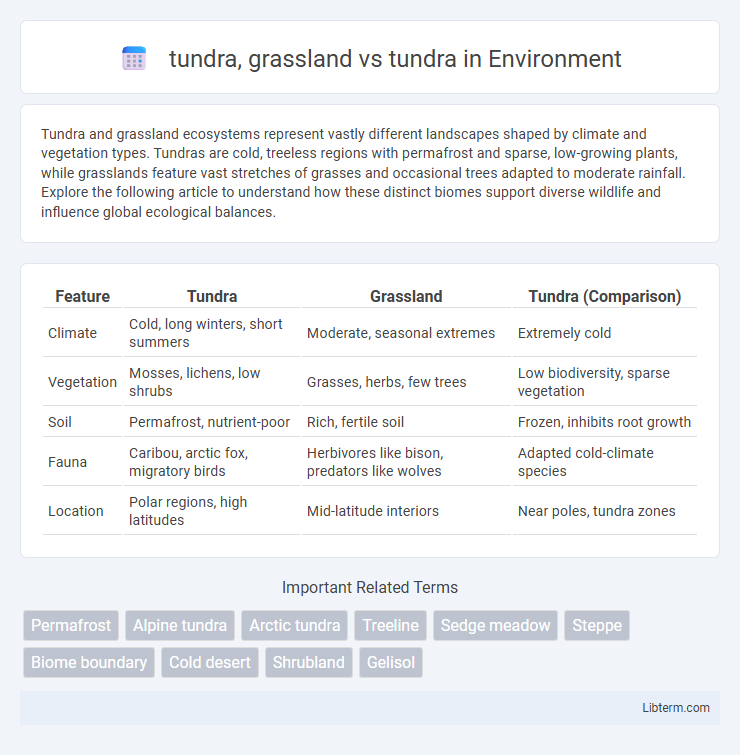Tundra and grassland ecosystems represent vastly different landscapes shaped by climate and vegetation types. Tundras are cold, treeless regions with permafrost and sparse, low-growing plants, while grasslands feature vast stretches of grasses and occasional trees adapted to moderate rainfall. Explore the following article to understand how these distinct biomes support diverse wildlife and influence global ecological balances.
Table of Comparison
| Feature | Tundra | Grassland | Tundra (Comparison) |
|---|---|---|---|
| Climate | Cold, long winters, short summers | Moderate, seasonal extremes | Extremely cold |
| Vegetation | Mosses, lichens, low shrubs | Grasses, herbs, few trees | Low biodiversity, sparse vegetation |
| Soil | Permafrost, nutrient-poor | Rich, fertile soil | Frozen, inhibits root growth |
| Fauna | Caribou, arctic fox, migratory birds | Herbivores like bison, predators like wolves | Adapted cold-climate species |
| Location | Polar regions, high latitudes | Mid-latitude interiors | Near poles, tundra zones |
Overview of Tundra and Grassland Ecosystems
Tundra ecosystems are characterized by cold temperatures, low precipitation, and permafrost, resulting in sparse vegetation dominated by mosses, lichens, and dwarf shrubs. Grassland ecosystems experience warmer temperatures with moderate rainfall, supporting dense grasses and herbaceous plants adapted to periodic fires and grazing. Both ecosystems play crucial roles in carbon storage and biodiversity conservation, with tundra regions significantly influencing global climate regulation through their frozen organic matter.
Defining Characteristics of the Tundra Biome
The tundra biome is defined by its cold, dry climate, permafrost soil, low biodiversity, and short growing seasons, contrasting sharply with grasslands which have warmer temperatures and richer soils supporting dense vegetation. Tundra vegetation includes mosses, lichens, and dwarf shrubs adapted to extreme conditions, while grasslands are dominated by grasses and herbaceous plants thriving in nutrient-rich soils. The tundra's harsh environment limits animal species primarily to specialized mammals and birds adapted to cold, unlike grasslands which support a broader range of fauna due to milder climates.
Key Features of Grassland Ecosystems
Grassland ecosystems are characterized by vast open spaces dominated by grasses, with few trees or shrubs, supporting diverse herbivore populations such as bison and antelope. Unlike the tundra, grasslands have richer soils and experience warmer temperatures, allowing for deeper root systems and higher primary productivity. Seasonal rainfall patterns in grasslands contribute to distinct plant and animal adaptations, promoting biodiversity and natural fire cycles that maintain ecosystem balance.
Geographic Distribution: Tundra vs Grassland
Tundra primarily spans the Arctic regions of North America, Europe, and Asia, characterized by permafrost and minimal vegetation due to cold, harsh climates. Grasslands dominate temperate regions such as the North American prairies, the Eurasian steppes, and parts of South America, thriving in moderate rainfall and well-drained soils. The geographic distribution of tundra is limited to polar and alpine zones, while grasslands cover extensive mid-latitude areas with seasonal temperature variations.
Climate Differences Between Tundra and Grassland
Tundra regions experience extremely cold temperatures with long, harsh winters and short, cool summers, characterized by permafrost and low precipitation, often less than 25 cm annually. In contrast, grasslands have moderate to warm temperatures with distinct seasonal changes and receive higher precipitation, typically between 50 and 90 cm annually, supporting dense vegetation. These climatic differences influence soil fertility and biodiversity, with tundras having poor nutrient soil due to frozen ground and grasslands exhibiting richer soil and greater plant and animal diversity.
Soil Composition and Nutrient Levels
Tundra soils are typically characterized by permafrost and low organic matter, resulting in poor nutrient availability and limited microbial activity. Grassland soils, in contrast, have rich organic content and higher nutrient levels due to abundant plant decay and earthworm activity, promoting soil fertility. The shallow active layer in tundra inhibits nutrient cycling, whereas grasslands exhibit deeper soil horizons supporting robust nutrient turnover.
Flora: Typical Plant Life in Tundra vs Grassland
Tundra flora primarily consists of low-growing plants such as mosses, lichens, sedges, and dwarf shrubs adapted to cold, nutrient-poor soils and short growing seasons. Grasslands are dominated by tall and short grasses, including species like bluestem, buffalo grass, and ryegrass, thriving in warmer climates with more fertile soils. Unlike grasslands, tundra vegetation lacks large trees and has a sparse, ground-hugging plant cover, enabling survival in harsh, permafrost-affected environments.
Fauna: Unique Wildlife of Tundra and Grasslands
The tundra hosts unique fauna such as Arctic foxes, caribou, and snowy owls adapted to its cold, harsh climate with low vegetation. Grasslands support diverse herbivores like bison, pronghorns, and zebras, alongside predators including wolves and lions, thriving in warmer, more vegetated environments. These ecosystems exhibit distinct wildlife adapted to their specific climatic conditions and vegetation types, reflecting evolutionary specialization.
Human Impact and Conservation Challenges
Human impact on tundra ecosystems includes disturbance from resource extraction, infrastructure development, and climate change-induced permafrost thaw, resulting in habitat degradation and altered biodiversity. Grasslands face challenges from agricultural expansion, overgrazing, and urbanization, leading to soil erosion, loss of native species, and reduced carbon sequestration capacity. Conservation efforts prioritize protecting permafrost areas in tundra and restoring native vegetation in grasslands to maintain ecosystem functions and resilience.
Comparative Summary: Tundra vs Grassland
Tundra ecosystems, characterized by permafrost and low temperatures, support limited vegetation mainly composed of mosses, lichens, and dwarf shrubs, contrasting with grasslands that thrive in moderate climates with fertile soils supporting dense grasses and herbaceous plants. Grasslands exhibit higher biodiversity and productivity due to longer growing seasons and richer nutrient availability, while tundras experience short growing periods and nutrient-poor soils limiting plant development. Both biomes play crucial roles in carbon sequestration, but tundras act as significant carbon sinks due to frozen soils, whereas grasslands efficiently cycle nutrients and support large herbivore populations.
tundra, grassland Infographic

 libterm.com
libterm.com